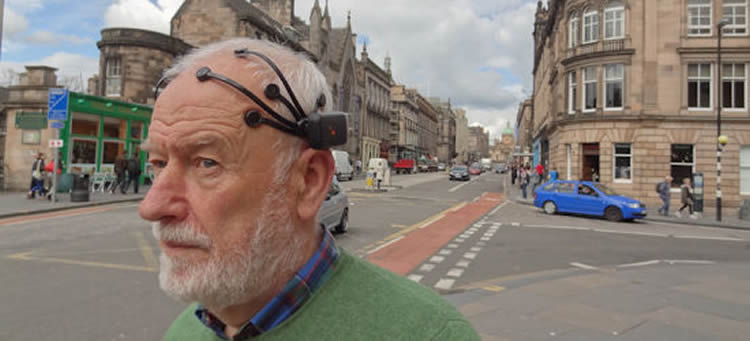Summary: According to a new EEG study, walking between busy environments and green spaces can alter mood and emotion, triggering excitment and frustration.
Source: University of York.
Walking between busy urban environments and green spaces triggers changes in levels of excitement, engagement and frustration in the brain, a study of older people has found.
Researchers at the Universities of York and Edinburgh say the findings have important implications for architects, planners and health professionals as we deal with an ageing population.
The study is part of a larger project looking at mobility, mood and place and the role of the urban environment in promoting lifelong health and wellbeing.
The aim of the study was to understand how older people experience different urban environments using electroencephalography (EEG), self-reported measures, and interviews.
As part of the experiment, eight volunteers aged 65 and over (from a wider sample of 95 people aged 65 and over) wore a mobile EEG head-set which recorded their brain activity when walking between busy and green urban spaces.
The research team also ran a video of the routes the people walked, asking the participants to describe “snapshots” of how they felt. The volunteers were also interviewed before and after.
The volunteers experienced beneficial effects of green space and preferred it, as it was calming and quieter, the study revealed.
Dr Chris Neale, Research Fellow, from the University of York’s Stockholm Environment Institute, said: “There are concerns about mental wellbeing as the global population becomes older and more urbanised.
“Urban green space has a role to play in contributing to a supportive city environment for older people through mediating the stress induced by built up settings.
“We found that older participants experienced beneficial effects of green space whilst walking between busy built urban environments and urban green space environments. Indeed, this work is the first to be published in a series of papers understanding the impact of green and urban spaces on brain activity in older adults.
“In a time of austerity, when greens spaces are possibly under threat due to pressure on council funding, we have demonstrated that these areas are important to people’s health.

“We have an ageing population which places challenges on the NHS. As the cost of looking after an ageing population continues to rise, maintaining access to green space could be a relatively low cost option for improving mental wellbeing.”
Dr Sara Tilley, Research Fellow, from the University of Edinburgh, added: “To help ensure that living longer is a positive experience for everyone, we need evidence-based solutions to support lifelong health and wellbeing.
“These findings – and others from the same project which show how important places are for our personal and cultural memories, and for enabling us to stay connected socially – have implications for the way we design for people of all ages, backgrounds and abilities so that going outdoors in younger years becomes a lifelong passion for getting out and about.”
Funding: It was funded by the Research Councils UK under the Lifelong Health and Wellbeing Cross-Council Programme.
Details about the project can be found here.
Source: Alistair Keely – University of York
Image Source: NeuroscienceNews.com image is adapted from the University of York news release.
Original Research: Full open access research for “Older People’s Experiences of Mobility and Mood in an Urban Environment: A Mixed Methods Approach Using Electroencephalography (EEG) and Interviews” by Sara Tilley, Chris Neale, Agnès Patuano and Steve Cinderby in International Journal of Environmental Research and Public Health. Published online February 4 2017 doi:10.3390/ijerph14020151
[cbtabs][cbtab title=”MLA”]University of York “Why Green Spaces Are Good For Gray Matter.” NeuroscienceNews. NeuroscienceNews, 10 April 2017.
<https://neurosciencenews.com/green-spaces-neurobiology-6376/>.[/cbtab][cbtab title=”APA”]University of York (2017, April 10). Why Green Spaces Are Good For Gray Matter. NeuroscienceNew. Retrieved April 10, 2017 from https://neurosciencenews.com/green-spaces-neurobiology-6376/[/cbtab][cbtab title=”Chicago”]University of York “Why Green Spaces Are Good For Gray Matter.” https://neurosciencenews.com/green-spaces-neurobiology-6376/ (accessed April 10, 2017).[/cbtab][/cbtabs]
Abstract
Older People’s Experiences of Mobility and Mood in an Urban Environment: A Mixed Methods Approach Using Electroencephalography (EEG) and Interviews
There are concerns about mental wellbeing in later life in older people as the global population becomes older and more urbanised. Mobility in the built environment has a role to play in improving quality of life and wellbeing, as it facilitates independence and social interaction. Recent studies using neuroimaging methods in environmental psychology research have shown that different types of urban environments may be associated with distinctive patterns of brain activity, suggesting that we interact differently with varying environments. This paper reports on research that explores older people’s responses to urban places and their mobility in and around the built environment. The project aim was to understand how older people experience different urban environments using a mixed methods approach including electroencephalography (EEG), self-reported measures, and interview results. We found that older participants experience changing levels of “excitement”, “engagement” and “frustration” (as interpreted by proprietary EEG software) whilst walking between a busy built urban environment and an urban green space environment. These changes were further reflected in the qualitative themes that emerged from transcribed interviews undertaken one week post-walk. There has been no research to date that has directly assessed neural responses to an urban environment combined with qualitative interview analysis. A synergy of methods offers a deeper understanding of the changing moods of older people across time whilst walking in city settings.
“Older People’s Experiences of Mobility and Mood in an Urban Environment: A Mixed Methods Approach Using Electroencephalography (EEG) and Interviews” by Sara Tilley, Chris Neale, Agnès Patuano and Steve Cinderby in International Journal of Environmental Research and Public Health. Published online February 4 2017 doi:10.3390/ijerph14020151






